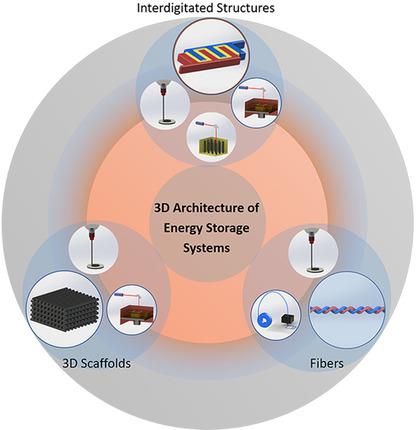当前位置:
X-MOL 学术
›
Batteries Supercaps
›
论文详情
Our official English website, www.x-mol.net, welcomes your
feedback! (Note: you will need to create a separate account there.)
3D Printing of Electrochemical Energy Storage Devices: A Review of Printing Techniques and Electrode/Electrolyte Architectures
Batteries & Supercaps ( IF 5.1 ) Pub Date : 2020-01-09 , DOI: 10.1002/batt.201900130 Meng Cheng 1 , Ramasubramonian Deivanayagam 1 , Reza Shahbazian‐Yassar 1
Batteries & Supercaps ( IF 5.1 ) Pub Date : 2020-01-09 , DOI: 10.1002/batt.201900130 Meng Cheng 1 , Ramasubramonian Deivanayagam 1 , Reza Shahbazian‐Yassar 1
Affiliation

|
Recently, the fabrication of electrochemical energy storage (EES) devices via three‐dimensional (3D) printing has drawn considerable interest due to the enhanced electrochemical performances that arise from well‐designed EES device architectures as compared to the conventionally fabricated ones. This work summarizes the developments in electrochemical devices fabricated by 3D printing techniques. We have categorized this review based on the architectural design of 3D printed EES devices: interdigitated structures, 3D scaffolds, and fibers. The printing techniques, processes, printing materials, advantages, and disadvantages of 3D printed architectures are systematically discussed in this review. Enhanced power density and energy density values were obtained using interdigitated structures and 3D scaffolds, in comparison with the conventional planar structure. The reasons for better electrochemical performances can be attributed to the presence of higher loading active materials, larger footprint area, and shorter ion transport route. The 3D printing techniques have also enabled the EES devices to be fabricated into lightweight, flexible fibers, and to be integrated into wearable electronics. At the end, the challenges and outlooks on the fabrication of 3D structured EES devices are outlined.
中文翻译:

电化学储能设备的3D打印:打印技术和电极/电解质体系结构的回顾
近来,由于与常规制造的结构相比,精心设计的EES器件结构增强了电化学性能,因此通过三维(3D)打印制造电化学能量存储(EES)器件引起了极大的兴趣。这项工作总结了通过3D打印技术制造的电化学装置的发展。我们根据3D打印EES设备的体系结构设计对这篇评论进行了归类:叉指结构,3D支架和纤维。在这篇综述中系统地讨论了3D打印体系结构的打印技术,过程,打印材料,优点和缺点。使用叉指结构和3D支架可获得增强的功率密度和能量密度值,与传统的平面结构相比。更好的电化学性能的原因可以归因于存在较高的负载活性材料,较大的覆盖面积和较短的离子传输路径。3D打印技术还使EES设备可以制造成轻巧,柔软的纤维,并可以集成到可穿戴电子设备中。最后,概述了3D结构EES设备制造中的挑战和前景。
更新日期:2020-01-09
中文翻译:

电化学储能设备的3D打印:打印技术和电极/电解质体系结构的回顾
近来,由于与常规制造的结构相比,精心设计的EES器件结构增强了电化学性能,因此通过三维(3D)打印制造电化学能量存储(EES)器件引起了极大的兴趣。这项工作总结了通过3D打印技术制造的电化学装置的发展。我们根据3D打印EES设备的体系结构设计对这篇评论进行了归类:叉指结构,3D支架和纤维。在这篇综述中系统地讨论了3D打印体系结构的打印技术,过程,打印材料,优点和缺点。使用叉指结构和3D支架可获得增强的功率密度和能量密度值,与传统的平面结构相比。更好的电化学性能的原因可以归因于存在较高的负载活性材料,较大的覆盖面积和较短的离子传输路径。3D打印技术还使EES设备可以制造成轻巧,柔软的纤维,并可以集成到可穿戴电子设备中。最后,概述了3D结构EES设备制造中的挑战和前景。











































 京公网安备 11010802027423号
京公网安备 11010802027423号